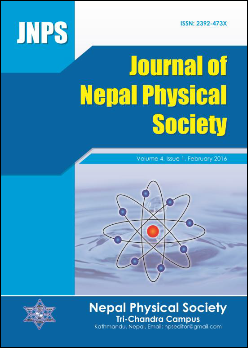Quality Assurance with Dosimetric Consistency of a Co-60 Teletherapy Unit
DOI:
https://doi.org/10.3126/jnphyssoc.v4i1.17341Keywords:
Quality Assurance, Dosimetry, Teletherapy Unit, Output Dose, Consistency, ICRU, IAEAAbstract
It is essential to know the standard dose rate, output of Co-60 source in the radiation treatment periodically. It is because the over dosage may cause radiation hazards where as under dosage may lead to unsatisfactory treatment of cancer. Present study focused on the radiation standards and dosimetry for the assurance of the quality and verify that the output of the ionizing radiation emitting medical instruments such as Teletherapy Unit (TTU) which should be within ±2% of the stated one. Present study was done as a part of the regularity of quality assurance (QA) of telecobalt radiotherapy unit that includes the dosimetric measurements of Co-60 TTU at Bhaktapur Cancer Hospital (BCH), Bhaktapur per each month from 29 March 2012 to 29 December 2014. The radionuclide source is Co-60 which has been incorporated in TTU, BCH for the purpose of therapeutic treatment of cancer. The Co-60 source decays continuously to Ni-60 (half-life of 5.27 years) with the decrease in its activity and hence the output dose rate. The calculations of actual dose rate of Co-60 TTU were done by the source to surface distance (SSD) technique. It has been concluded that there is a quality assurance management in Co-60 TTU, BCH with the consistency in the average output dose rate obtained by the actual dosimetry values and the expected output values obtained by decay method. The values obtained by actual dosimetry are within ±2% of the expected values so that the deviation of the actual output dose rate from the expected output data lies within the permissible limit as prescribed by International Atomic Energy Agency (IAEA) and International Commission on Radiation Units and Measurement (ICRUM). In conclusion, our study shows a trend towards uniform and better dose delivery from Co-60 TTU, BCH, Nepal
Journal of Nepal Physical Society
Volume 4, Issue 1, February 2017, Page: 88-92
Downloads
Downloads
Published
How to Cite
Issue
Section
License
All right reserved. No part of this Journal may be reproduced in any form or by any electronic or mechanical means, including information storage and retrieval system, without permission in writing from the publisher, except by a reviewer who may quote brief passage in a review. The views and interpretation in this journal are those of author(s) and they are not attributable to the NPS.




